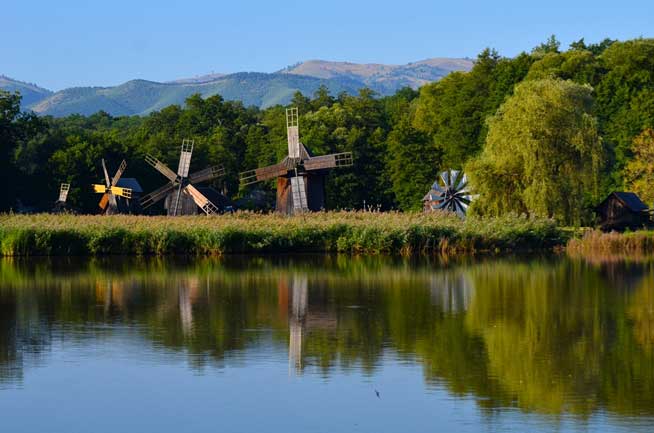The ASTRA National Museum Complex (or in short ASTRA Museum) is one of the largest ethnographic museums in Europe. Its open-air exhibition includes over 400 monuments of peasant architecture and technology covering a surface of approximately forty hectares. The origins of the museum can be found in the ethnographic collections assembled by the Transylvanian Association for Romanian Literature and the Culture of the Romanian People (Asociaţiunea Transilvană pentru Literatura Română şi Cultura Poporului Română or in short ASTRA), an institution that played a major role in the cultural emancipation of Transylvanian Romanians after its establishment in 1861. These collections, assembled beginning with the second half of the nineteenth century, were exhibited at the ASTRA Museum that opened in 1905 in the palace built by the Association for this purpose in the centre of Sibiu. In 1931, the museum already owned over 11,000 ethnographic pieces from Transylvania. After 1918, Transylvania’s integration into the Kingdom of Romania meant the start of a new era in the development of the institution, which now received financial support from the Romanian government. In 1950, two years after the establishment of the communist regime, the ASTRA Museum was closed because the ASTRA Association was perceived as a cultural institution of the Romanian bourgeoisie in Transylvania. As a result, the ethnographic collection was transferred into the custody of the Brukenthal Museum.
In 1956, Cornel Irimie founded the Museum’s Folk Art Section by starting from the collection inherited from the ASTRA Museum. In 1963, on Irimie’s initiative the open-air Museum of Folk Technics (Muzeul Tehnicii Populare) was established on the outskirts of Sibiu. It includes, among other things, peasant dwellings and many artefacts created by craftsmen. Administratively, the new museum, open to the public in 1967, was in fact a department of the Brukenthal Museum. Between the 1960s and the 1980s, researchers and museologists from the Museum of Folk Technics conducted ethnographic field research on the religious beliefs of the rural population. The findings of this research can still be found in the archives of the ASTRA National Museum Complex.
In February 1990, by decision of the Sibiu Town Hall, the Museum of Traditional Folk Civilisation in Romania was established. This institution was independent from the Brukenthal Museum and took over the entire patrimony of the former Museum of Folk Technics. In September of the same year, by decision of the Ministry of Culture, the acronym ASTRA was added to the name of the recently-created museum as recognition of the kinship between the association’s former ASTRA Museum and the new ASTRA Museum. In 2001, the ASTRA National Museum Complex was founded. This structure included several ethnographic museums in Sibiu, such as the ASTRA Museum of Traditional Folk Civilisation, the Franz Binder Museum of World Ethnography, the ASTRA Museum of Transylvanian Civilisation, the Emil Sigerus Museum of Saxon Ethnography, and the projected Museum of Romany Culture and Civilisation. While the first museum in this complex continues with the tradition of the Museum of Folk Technics, founded by Cornel Irimie, the second reflects the ethnography of peoples from outside of the European area. The ASTRA Museum of Transylvanian Civilisation at present owns the collections inherited from the old ASTRA Museum, while the Emil Sigerius Museum of Saxon Ethnography displays the ethnographic collections portraying the rural civilisation of the Transylvanian Saxons. The future Museum of Romany Culture and Civilisation will exhibit the collections related to the culture and traditional crafts of the Roma people, which are at present owned by the ASTRA National Museum Complex. Beside these museums, the ASTRA museum complex also includes a department of anthropological documentary film, one of artefact conservation-restoration, one of museum studies and cultural marketing, a tourist information centre, and a publishing house (the ASTRA Museum Publishing House), as well as a project management department.

